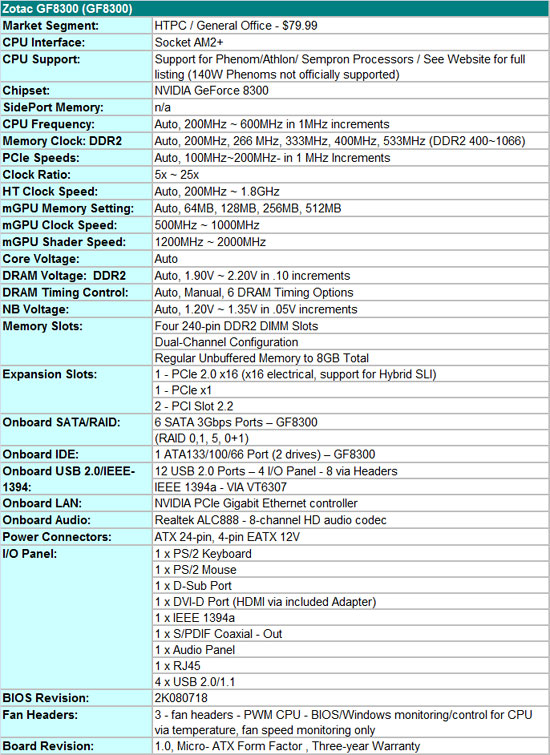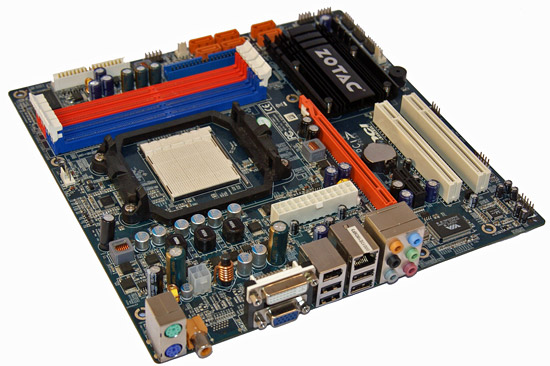The IGP Chronicles Part 2: AMD 780G vs. Intel G45 vs. NVIDIA GeForce 8200
by Gary Key on October 14, 2008 12:40 PM EST- Posted in
- Motherboards
NVIDIA GeForce 8300 by Zotac
Our second board is the Zotac GF8300 and it represents one of their first forays into the motherboard market. This board is a no-frills affair from the BIOS options down to the feature set. However, sometimes this is the best course to take in the low-end market; providing a high quality board that just gets the job done is a plus in our book. That also means that you need to get it right the first time.

Did Zotac get it right the first time? Not exactly, as this board has a couple of layout nuisances in our book. The placement of the 24-pin ATX power connector is in the wrong spot for most case designs and interferes with both airflow and cable management around the CPU area. It is something you can live with but we have seen better on other uATX boards. If you do utilize a dual slot GPU card (a rare event on these boards) then expect to lose the only PCIe x1 slot on the board and two SATA ports. Otherwise, the placement and design of the GF8300 heatsink scores points with us.

The BIOS design and options are minimalistic but do provide base functionality and the ability to overclock slightly. The BIOS is missing Core Voltage settings, something that we expect on all boards in this category - not just for the ability to overclock but also to undervolt the CPU when using the board in an HTPC setup.
The options on the board are decent, ranging from IEEE 1394a support from the VIA VT6307 to HD audio from the Realtek ALC888 (no real-time DTS or DD support) along with RAID 0, 1, 0+1, and 5 support. Zotac provides VGA and DVI-D outputs but notably missing is native HDMI. However, we did not have any problems utilizing the included DVI to HDMI adapter when running 7.1 channel HDMI audio out to our receiver. Zotac does offer decent CPU fan controls and monitoring; system fan control is missing but the BIOS does monitor fan speeds.
Zotac utilizes an excellent 3-phase power delivery system along with quality capacitors throughout the board that resulted in very good stability throughout our testing regimen. This board does not support the 140W TDP processors, although Zotac rates it for the 125W TDP processors provided there is good airflow across the PWM area. We have not had any problems with either the 9850BE or 9950BE in several hundred hours of testing, though the MOSFETs like squeal at times when under heavy loads. We recommend sticking to the Tri-Core Phenoms on this board; they also happen to be an excellent value/choice for HTPC or gaming at this time.
Without an overclocking friendly BIOS, we still managed to get our 8750e up to 235HTT and our 4850e to 232HTT before requiring core voltage for stability. We did not overclock our 9950BE in the hopes of saving the board from an early grave. The GF8300 is nothing more than a binned GF8200 and it shows on this board with mGPU shader clocks hitting 1750 MHz and mGPU core clock hitting 710 MHz.
Pros/Cons
We can sum this up quickly. The GF8300 is a good first try for Zotac in the AMD motherboard market. We hope that they will learn from a couple of layout mistakes on the next board. The BIOS needs core voltage settings and we would like to see native HDMI output along with an eSATA option. These boards will likely find their way into HTPC or SOHO setups and these options are important; in fact, a better audio solution would be nice also. Otherwise, the board was extremely stable during testing and we never once had a compatibility problem or a blue screen. Not too many boards can say that and for this reason, we placed the Zotac GF8300 high on our list, as stability is paramount in a system.














41 Comments
View All Comments
lisajack - Saturday, January 18, 2020 - link
Although, with MMA corner standards, I wouldn’t be surprised if somebody told her to go out there and do her best despite being completely out(weight)classed by the scale.https://www.nogibjjgear.com/collections/rash-guard...